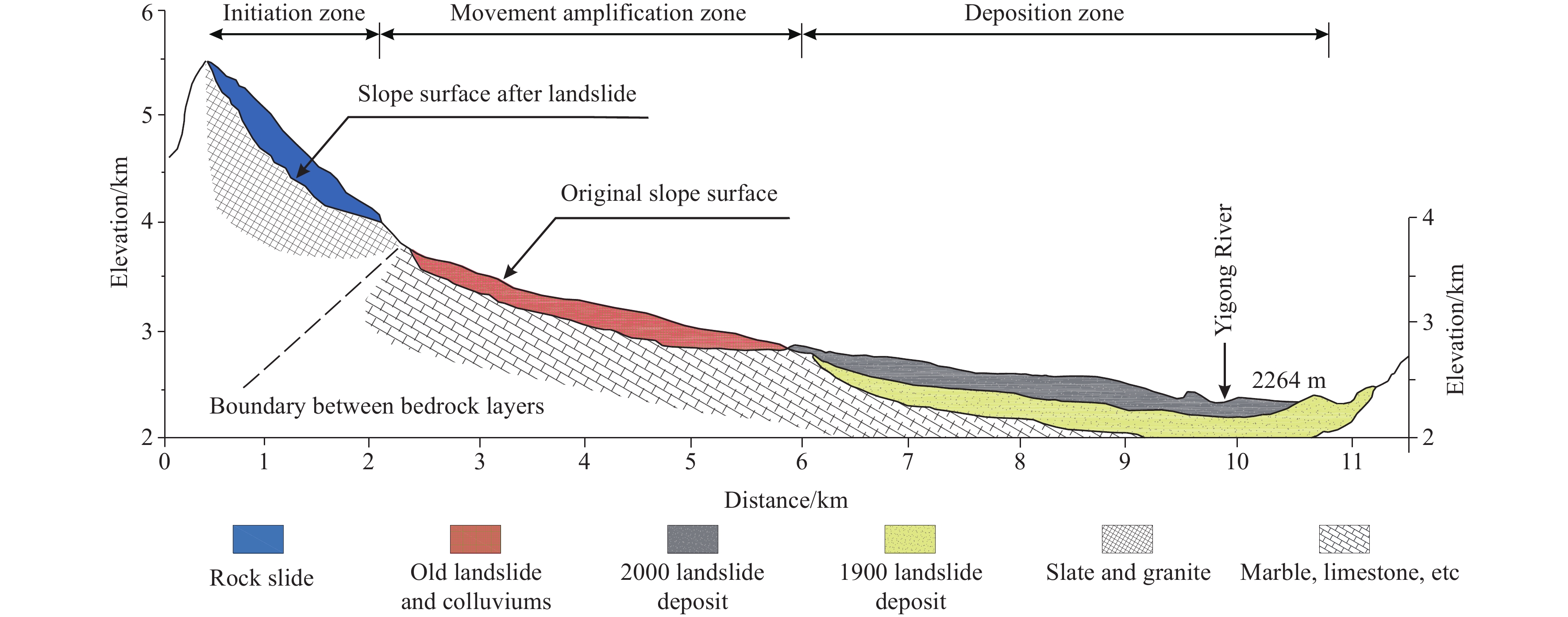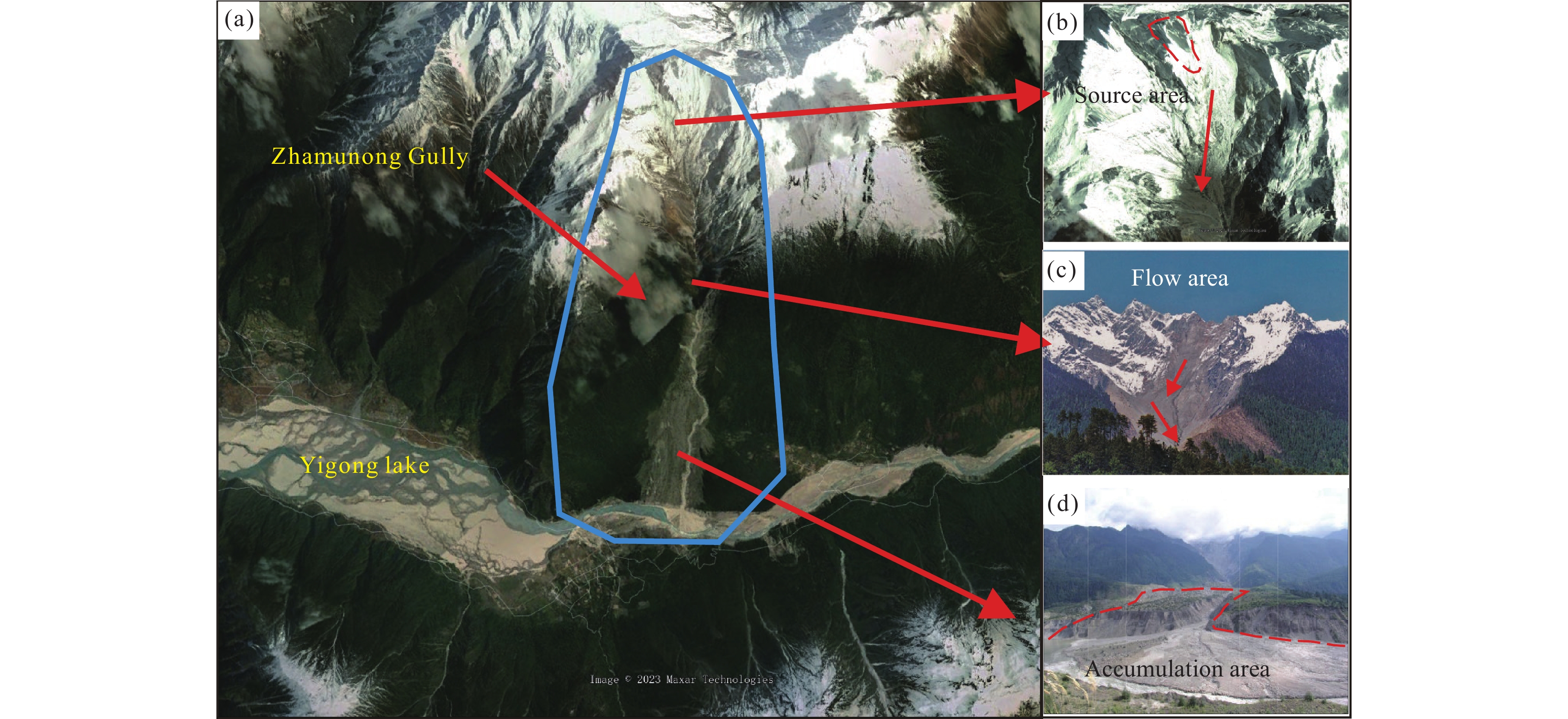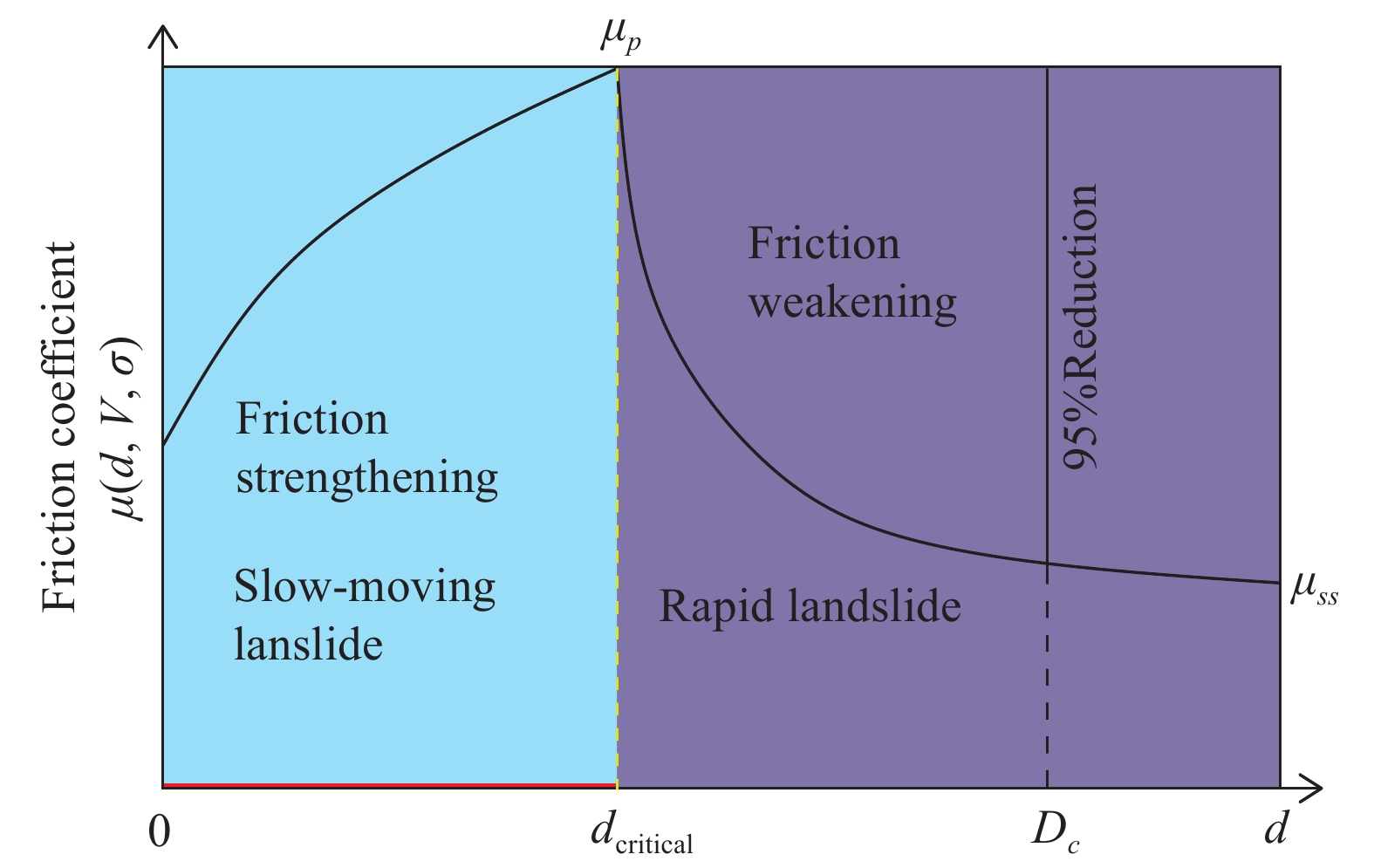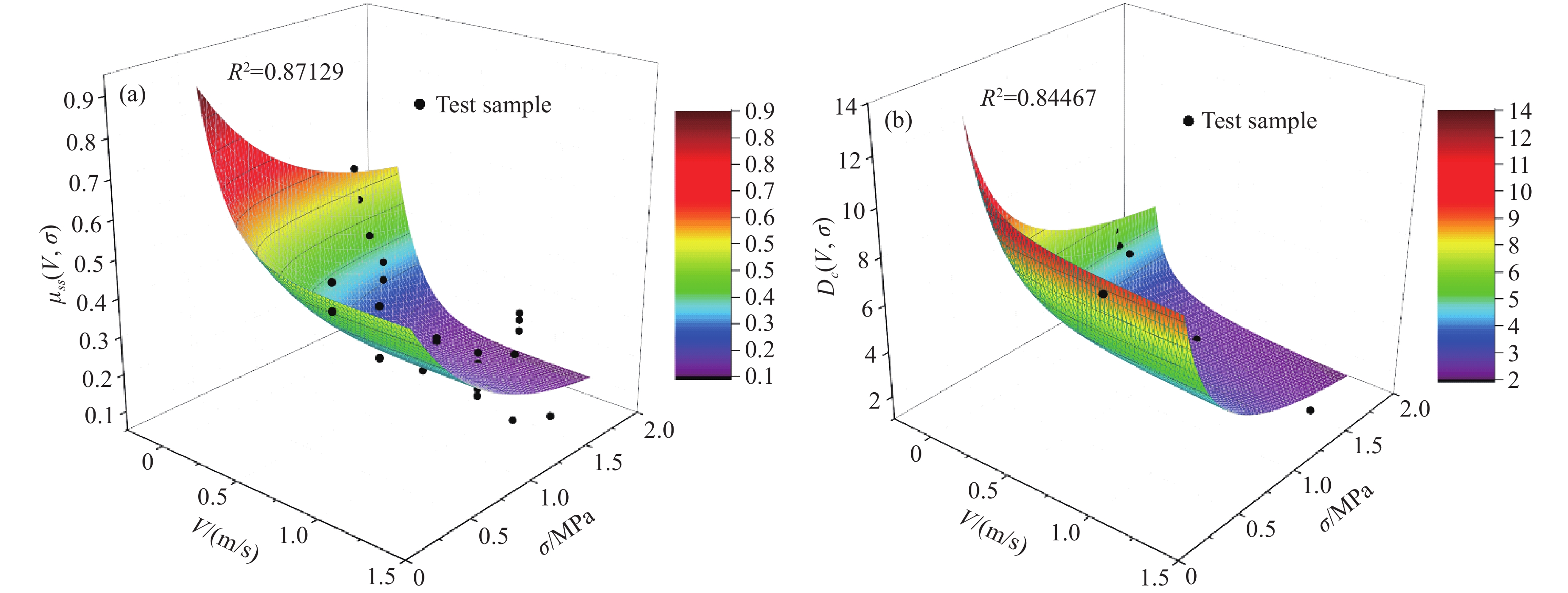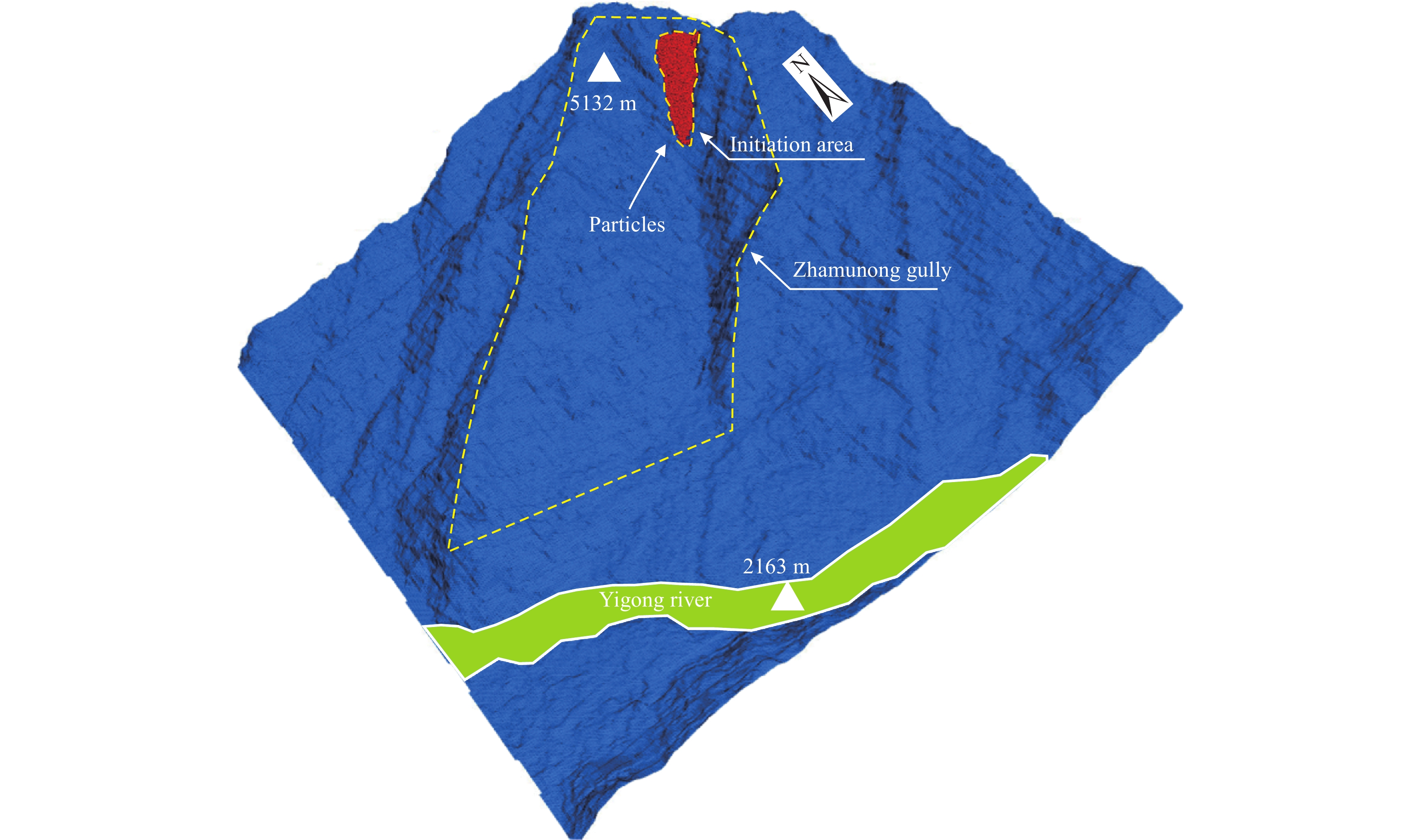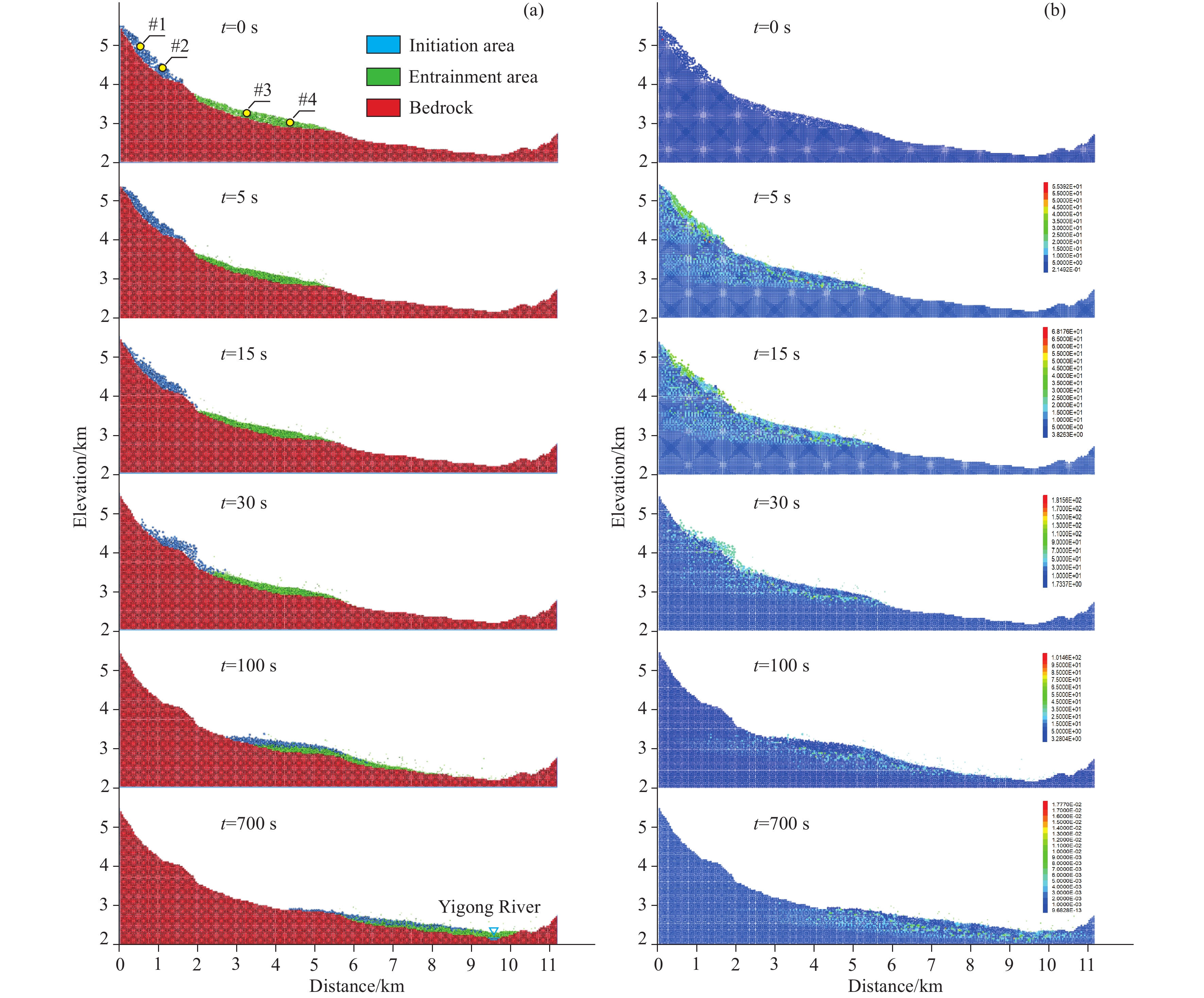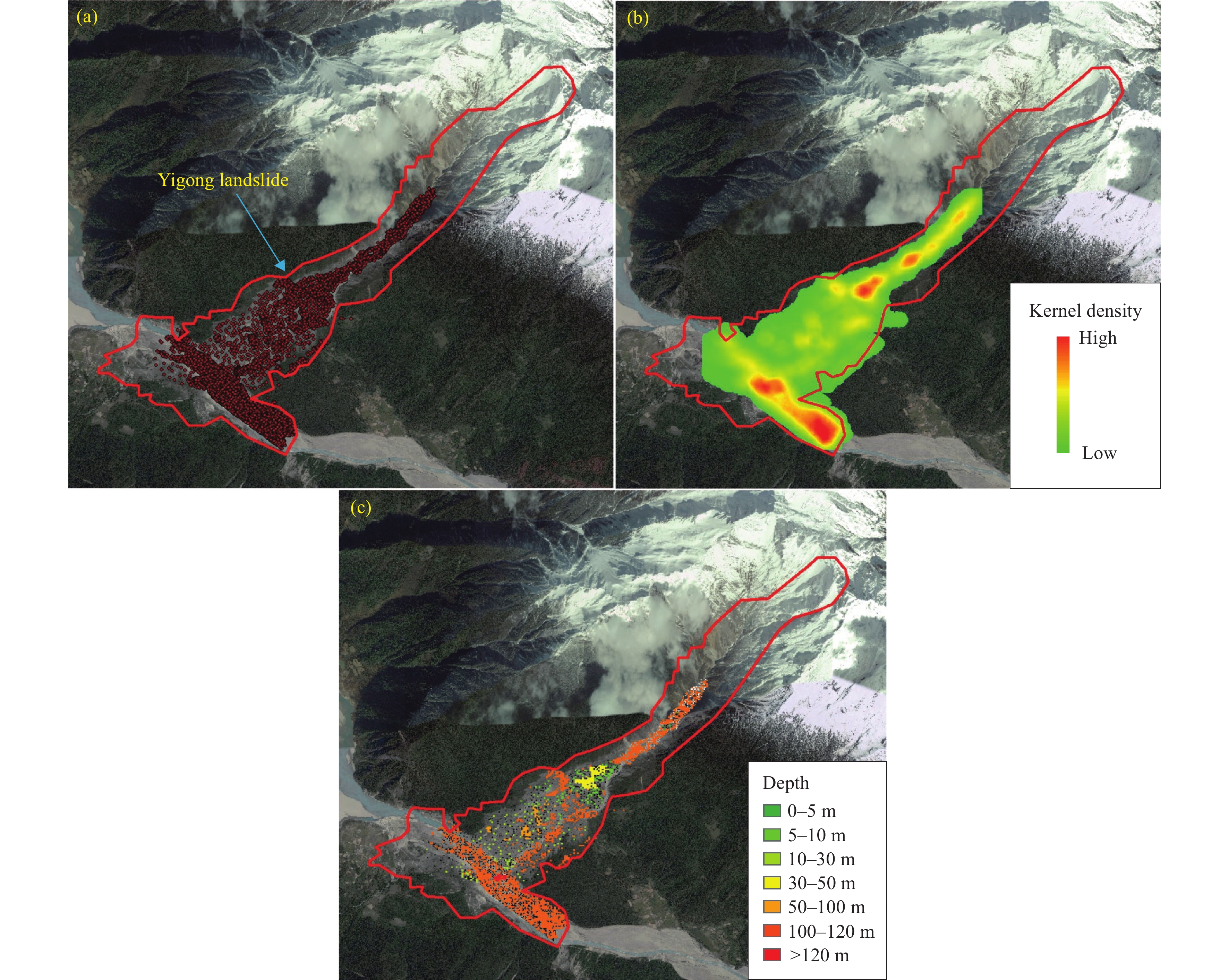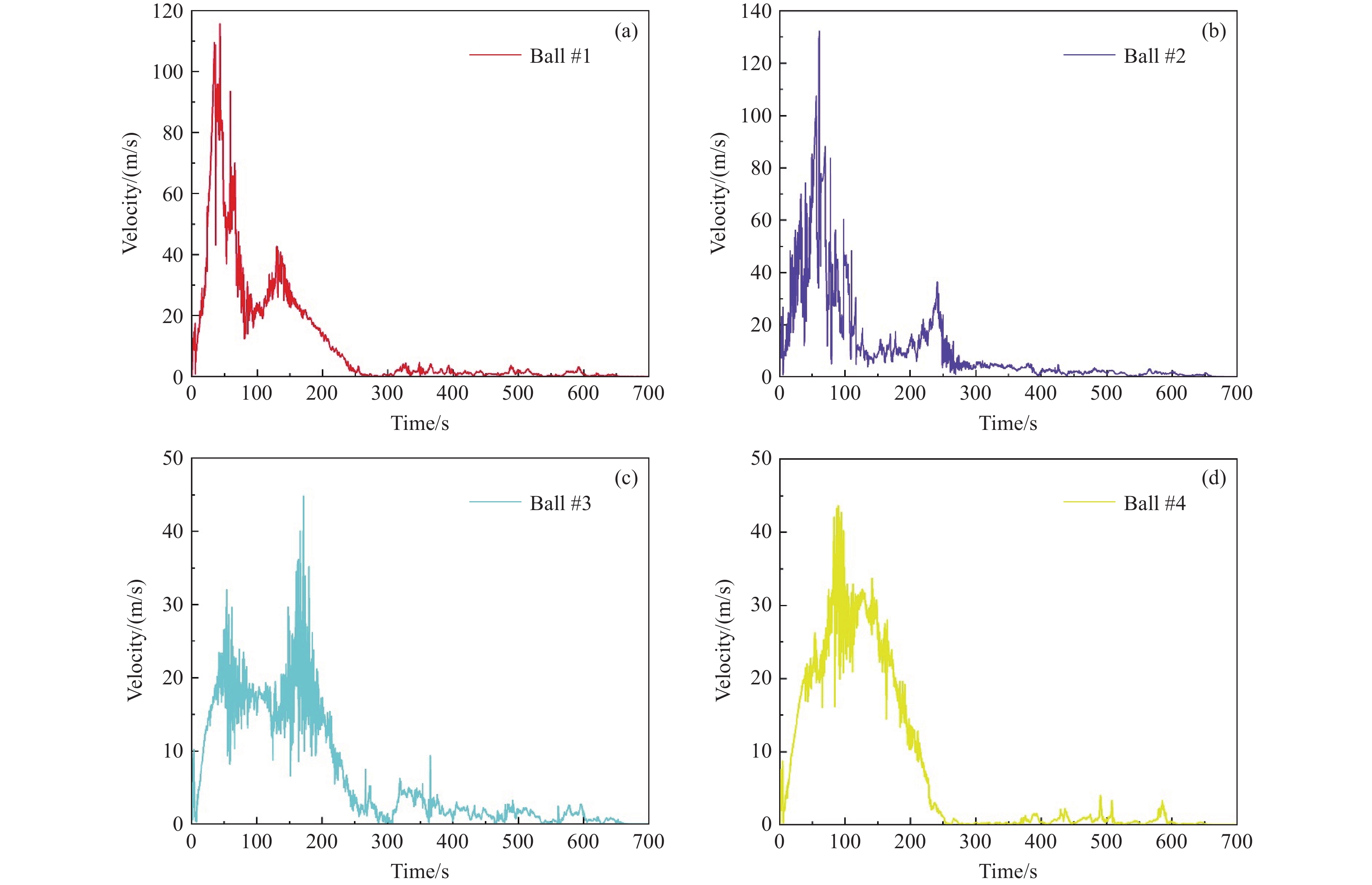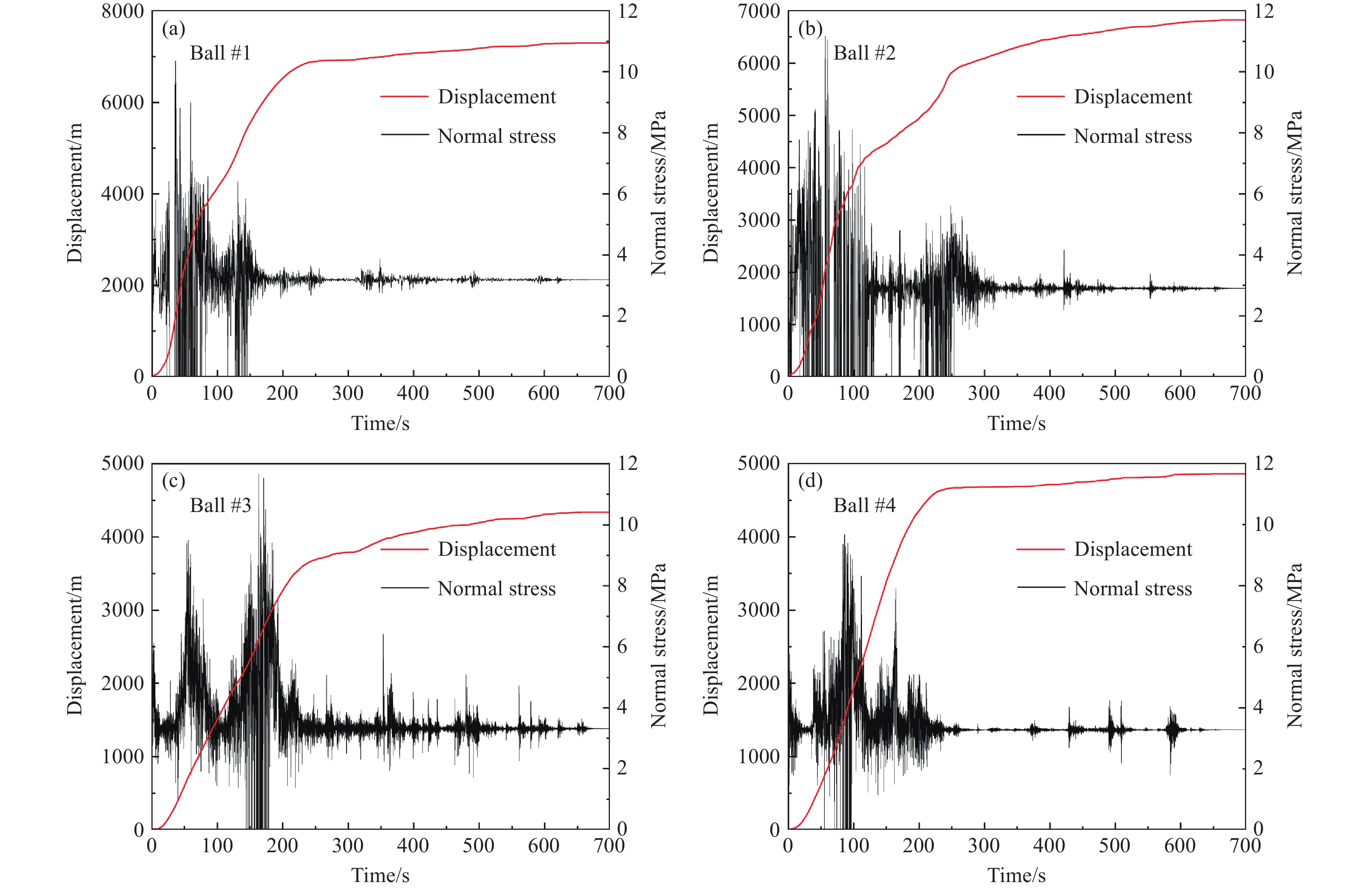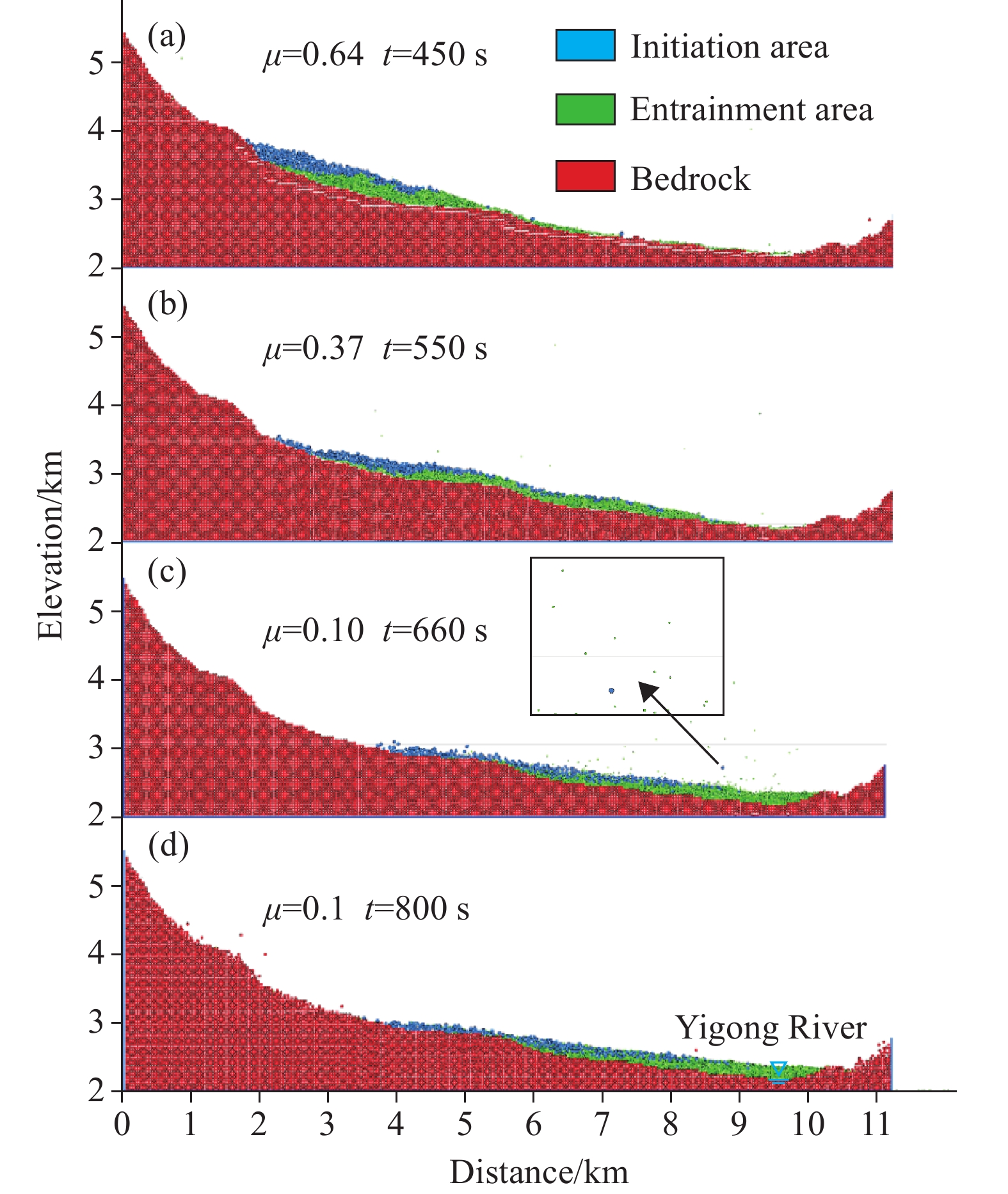| Citation: | Zi-zheng Guo, Xin-yong Zhou, Da Huang, Shi-jie Zhai, Bi-xia Tian, Guang-ming Li, 2024. Dynamic simulation insights into friction weakening effect on rapid long-runout landslides: A case study of the Yigong landslide in the Xizang Plateau, China, China Geology, 7, 222-236. doi: 10.31035/cg2023132 |
Dynamic simulation insights into friction weakening effect on rapid long-runout landslides: A case study of the Yigong landslide in the Xizang Plateau, China
-
Abstract
This study proposed a novel friction law dependent on velocity, displacement and normal stress for kinematic analysis of runout process of rapid landslides. The well-known Yigong landslide occurring in the Xizang Plateau of China was employed as the case, and the derived dynamic friction formula was included into the numerical simulation based on Particle Flow Code. Results showed that the friction decreased quickly from 0.64 (the peak) to 0.1 (the stead value) during the 5s-period after the sliding initiation, which explained the behavior of rapid movement of the landslide. The monitored balls set at different sections of the mass showed similar variation characteristics regarding the velocity, namely evident increase at the initial phase of the movement, followed by a fluctuation phase and then a stopping one. The peak velocity was more than 100 m/s and most particles had low velocities at 300s after the landslide initiation. The spreading distance of the landslide was calculated at the two-dimension (profile) and three-dimension scale, respectively. Compared with the simulation result without considering friction weakening effect, our results indicated a max distance of about 10 km from the initial unstable position, which fit better with the actual situation.
-

-
References
Agterberg F. 2022. How Can Earth Science Help Reduce the Adverse Effects of Climate Change? Journal of Earth Science, 33 (5), 1338–1338. doi:10.1007/s12583-022-1741-y Cai Z, Liu E, Chen N, Feng J, Hu G, Su Y. 2022. Numerical analysis of the initiation and sliding process of the Yigong landslide using a continuous–discontinuous method. Environmental Earth Sciences, 81(5), 150. doi: 10.1007/s12665-022-10279-y. Crozier MJ. 2010. Deciphering the effect of climate change on landslide activity: A review. Geomorphology, 124(3–4), 260–267. doi: 10.1016/j.geomorph.2010.04.009. Cui P, Ge Y. , Li S, Li Z, Xu X, Zhou GGD, Chen H, Wang H, Lei Y, Zhou L, Yi S, Wu C, Guo J, Wang Q, Lan H, Ding M, Ren J, Zeng L, Jiang Y, Wang Y. 2022. Scientific challenges in disaster risk reduction for the Sichuan–Xizang Railway. Engineering Geology, 309, 106837. doi:10.1016/j.enggeo.2022.106837 Dawso AG, Matthews JA, Shakes RA. 2017. A Catastrophic Landslide (Sturzstrom) in Verkilsdalen, Rondane National Park, Southern Norway. Physical Geography, 68(1–2), 77–87. doi: 10.1080/04353676.1986.11880160. De Blasio FV, Elverho A. 2008. A model for frictional melt production beneath large rock avalanches. Journal of Geophysical Research: Earth Surface, 113, F02014. doi: 10.1029/2007JF000867. Delaney KB, Evans SG. 2015. The 2000 Yigong landslide (Xizang Plateau), rockslide-dammed lake and outburst flood: Review, remote sensing analysis, and process modelling. Geomorphology, 246, 377–393. doi: 10.1016/j.geomorph.2015.06.020. Dufresne A, Davies TR. 2009. Longitudinal ridges in mass movement deposits. Geomorphology, 105(3–4), 171–181. doi: 10.1016/j.geomorph.2008.09.009. Erismann TH. 1979. Mechanisms of large landslide. Rock Mechanics, 12, 15–46. doi: 10.1007/BF01241087. Fei M, Sun Q, Zhong D, Zhou GG. 2012. Simulations of granular flow along an inclined plane using the Savage–Hutter model. Particuology, 10(2), 236–241. doi: 10.1016/j.partic.2011.11.007. Feng ZY, Lo CM, Lin QF. 2017. The characteristics of the seismic signals induced by landslides using a coupling of discrete element and finite difference methods. Landslides, 14, 661–674. doi: 10.1007/s10346-016-0714-6. Fort M. 2000. Glaciers and mass wasting processes: their influence on the shaping of the Kali Gandaki valley (higher Himalaya of Nepal). Quaternary International, 65–66, 101–119. doi:10.1016/S1040-6182(99)00039-7 Goguel J. 1978. Chapter 20 - Scale-Dependent Rockslide Mechanisms, with Emphasis on the Role of Pore Fluid Vaporization. Rockslides and avalanches, 14, 693–705. Guo Z, Chen L, Yin K, Shrestha DP, Zhang L. 2020a. Quantitative risk assessment of slow-moving landslides from the viewpoint of decision-making: A case study of the Three Gorges Reservoir in China. Engineering Geology, 273, 105667. doi: 10.1016/j.enggeo.2020.105667. Guo C, Montgomery DR, Zhang Y, Zhong N, Fan C, Wu R, Yang Z, Ding Y, Jin J, Yan Y. 2020b. Evidence for repeated failure of the giant Yigong landslide on the edge of the Xizang Plateau. Scientific Reports, 10, 14371. doi: 10.1038/s41598-020-71335-w. Guo Z, Chen L, Gui L, Du J, Yin K, Do HM. 2020c. Landslide displacement prediction based on variational mode decomposition and WA-GWO-BP model. Landslides, 17, 567–583. doi: 10.1007/s10346-019-01314-4. Guo Z, Torra O, Hürlimann M, Medina V, Puig-Polo C. 2022a. FSLAM: A QGIS plugin for fast regional susceptibility assessment of rainfall-induced landslides. Environmental Modelling and Software, 150, 105354. doi: 10.1016/j.envsoft.2022.105354. Guo J, Cui Y, Xu W, Shen W, Li T, Yi S. 2022b. A novel friction weakening-based dynamic model for landslide runout assessment along the Sichuan-Xizang Railway. Engineering Geology, 306, 106721. doi: 10.1016/j.enggeo.2022.106721. Guo Z, Tian B, He J, Xu C, Zeng T, Zhu Y. 2023. Hazard assessment for regional typhoon-triggered landslides by using physically-based model -A case study from southeastern China. Georisk: Assessment and Management of Risk for Engineered Systems and Geohazards, 17(4), 740–754. doi: 10.1080/17499518.2023.2188465. Guo Z, Tian B, Zhu Y, He J, Zhang T. 2024. How do the landslide and non-landslide sampling strategies impact landslide susceptibility assessment? — A case study at catchment scale from China. Journal of Rock Mechanics and Geotechnical Engineering, 16(3), 877–894. doi: 10.1016/j.jrmge.2023.07.026. Hsu K J. 1975. Catastrophic debris streams (sturzstroms) generated by rockfalls. Geological Society of America Bulletin, 86(1), 129–140. doi: 10.1130/0016-7606(1975)86<129:CDSSGB>2.0.CO;2. Hu K, Wu C, Wei L, Zhang X, Zhang Q, Liu W, Yanites BJ. 2021. Geomorphic effects of recurrent outburst superfloods in the Yigong River on the southeastern margin of Xizang. Scientific Reports, 11(1), 15577. doi: 10.1038/s41598-021-95194-1. Huang T, Ding M, She T, Tian S, Yang J. 2017. Numerical simulation of a high-speed landslide in Chenjiaba, Beichuan, China. Engineering Geology, 14(11), 2137–2149. doi: 10.1007/s11629-017-4516-7. Huang F, Xiong H, Chen S, Lv Z, Huang J, Chang Z, Catani F. 2023. Slope stability prediction based on a long short-term memory neural network: comparisons with convolutional neural networks, support vector machines and random forest models. International Journal of Coal Science and Technology, 10(1), 18. doi: 10.1007/s40789-023-00579-4. Hungr O, Leroueil S, Picarelli L. 2014. The Varnes classification of landslide types, an update. Landslides, 11(2), 167–194. doi: 10.1007/s10346-013-0436-y. Hungr O, McDougall S. 2009. Two numerical models for landslide dynamic analysis. Computers and Geosciences, 35(5), 978–992. doi: 10.1016/j.cageo.2007.12.003. Hürlimann M, Guo Z, Puig-Polo C, Medina V. 2022. Impacts of future climate and land cover changes on landslide susceptibility: regional scale modelling in the Val d'Aran region (Pyrenees, Spain). Landslides, 19(1), 99–118. doi: 10.1007/s10346-021-01775-6. Iverson RM, Ouyang C. 2015. Entrainment of bed material by Earth-surface mass flows: Review and reformulation of depth-integrated theory. Reviews of Geophysics, 53(1), 27–58. doi: 10.1002/2013RG000447. Jaboyedoff M, Oppikofer T, Abellán A, Derron MH, Loye A, Metzger R, Pedrazzini A. 2012. Use of LIDAR in landslide investigations: a review. Natural hazards, 61, 5–28. doi: 10.1007/s11069-010-9634-2. Lin A, Ren Z, Kumahara Y. 2010. Structural analysis of the coseismic shear zone of the 2008 Mw 7.9 Wenchuan earthquake, China. Journal of Structural Geology, 32 (6), 781–791. doi:10.1016/j.jsg.2010.05.004 Liu H D, Li D D, Wang Z F. 2018. Dynamic process of the Wenjiagou rock landslide in Sichuan Province, China. Arabian Journal of Geosciences, 11, 1–19. doi: 10.1007/s12517-018-3564-9. Liu W, He S. 2018. Dynamic simulation of a mountain disaster chain: landslides, barrier lakes, and outburst floods. Natural Hazards, 90, 757–775. doi: 10.1007/s11069-017-3073-2. Liu W, He S, Li X, Xu Q. 2016. Two-dimensional landslide dynamic simulation based on a velocity-weakening friction law. Landslides, 13, 957–965. doi: 10.1007/s10346-015-0632-z. Luo J, Pei X, Evans SG, Huang R. 2019. Mechanics of the earthquake-induced Hongshiyan landslide in the 2014 Mw 6.2 Ludian earthquake, Yunnan, China. Engineering Geology, 251, 197–213. doi:10.1016/j.enggeo.2018.11.011 Ma P, Peng J, Zhuang J, Zhu X, Liu C, Cheng Y, Zhang Z. 2022. Initiation Mechanism of Loess Mudflows by Flume Experiments. Journal of Earth Science, 33(5), 1166–1178. doi: 10.1007/s12583-022-1660-y. Melosh HJ. 1979. Acoustic fluidization: A new geologic process? Journal of Geophysical Research: Solid Earth, 84 (B13), 7513–7520. doi:10.1029/JB084iB13p07513 Mizoguchi K, Hirose T, Shimamoto T, Fukuyama E. 2007. Reconstruction of seismic faulting by high-velocity friction experiments: An example of the 1995 Kobe earthquake. Geophysical Research Letters, 34(1), L01038. doi: 10.1029/2006GL027931. Moore DE, Lockner, DA. 2008. Talc friction in the temperature range 25–400 C: Relevance for fault-zone weakening. Tectonophysics, 449(1-4), 120–132. doi: 10.1016/j.tecto.2007.11.039. Ouyang C, Zhao W, He S, Wang D, Zhou S, An H, Wang Z, Cheng D. 2017. Numerical modeling and dynamic analysis of the 2017 Xinmo landslide in Maoxian County, China. Journal of Mountain Science, 14, 1701–1711. doi: 10.1007/s11629-017-4613-7. Oldrich H, McDougal S. 2009. Two numerical models for landslide dynamic analysis. Computers and geosciences, 35(5), 978–992. doi: 10.1016/j.cageo.2007.12.003. Pritchard MA, Savigny K. 1991. The Heather Hill landslide: an example of a large scale toppling failure in a natural slope. Canadian Geotechnical Journal, 28(3), 410–422. doi: 10.1139/t91-051. Potyondy DO, Cundall PA. 2004. A bonded-particle model for rock. International journal of rock mechanics and mining sciences, 41(8), 1329–1364. doi: 10.1016/j.ijrmms.2004.09.011. Qi W, Yang W, He X, Xu C. 2021. Detecting Chamoli landslide precursors in the southern Himalayas using remote sensing data. Landslides, 18, 3449–3456. doi: 10.1007/s10346-021-01753-y. Royden LH, Burchfiel BC, Van Der Hilst R. 2008. The Geological Evolution of the Xizang Plateau. Science, 321(5892), 1054–1058. doi: 10.1126/science.115537. Schneider D, Huggei C, Haeberli W, Kaitna R. 2011. Unraveling driving factors for large rock–ice avalanche mobility. Earth Surface Processes and Landforms, 36(14), 1948–1966. doi: 10.1002/esp.2218. Shang Y, Yang Z, Li L, Liao Q, Wang Y. 2003. A super-large landslide in Xizang in 2000: background, occurrence, disaster, and origin. Geomorphology, 54(3–4), 225–243. doi: 10.1016/S0169-555X(02)00358-6. Shen P, Zhang L, Wong H, Deng D, Zhou S, Zhang S, Chen C. 2020. Debris flow enlargement from entrainment: A case study for comparison of three entrainment models. Engineering Geology. 270, 105581. doi:10.1016/j.enggeo.2020.105581 Song Y, Huang D, Ce D. 2016. Numerical modelling of the 2008 Wenchuan earthquake-triggered Daguangbao landslide using a velocity and displacement dependent friction law. Engineering Geology, 215, 50–68. doi: 10.1016/j.enggeo.2016.11.003. Song D, Du H. 2023. Numerical Investigation of the Evolution Process of an Open-Pit Mine Landslide Using Discrete-Element Method. International Journal of Geomechanics, 23(6), 7568. doi: 10.1061/IJGNAI.GMENG-7568. Spagnuolo E, Nielsen S, Violay M, Di Toro G. 2016. An empirically based steady state friction law and implications for fault stability. Geophysical Research Letters, 43(7), 3263–3271. doi: 10.1002/2016GL067881. Su A, Feng M, Dong S, Zou Z, Wang J. 2022. Improved statically solvable slice method for slope stability analysis. Journal of Earth Science, 33(5), 1190–1203. doi: 10.1007/s12583-022-1631-3. Wang F, Sun P, Highland L, Cheng Q. 2013. Initiation and motion mechanism of the Donghekou rapid and long runout landslide triggered by the 2008 Wenchuan earthquake, China. Earthquake-Induced Landslides, 473–483. doi:10.1007/978-3-642-32238-9_50 Wang W, Chen G, Zhang H, Zhou S, Liu S, Wu Y Q, Fan F. 2016. Analysis of landslide-generated impulsive waves using a coupled DDA-SPH method. Engineering Analysis with Boundary Elements, 64, 267–277. doi: 10.1016/j.enganabound.2015.12.014. Wang Y, Dong J, Cheng Q. 2017. Velocitdepey-ndent frictional weakening of large rock avalanche basal facies: Implications for rock avalanche hypermobility? Journal of Geophysical Research: Solid Earth, 122 (3), 1648–1676. doi:10.1002/2016JB013624 Wang Y, Dong J, Cheng Q. 2018. Normal stress-dependent frictional weakening of large rock avalanche basal facies: Implications for the rock avalanche volume effect. Journal of Geophysical Research:Solid Earth, 123(4), 3270–3282. doi: 10.1002/2018JB015602. Wang Z. 2006. Large scale individual landslide remote sensing. Earth Science Frontiers, 13(5), 516. (in Chinese with English Wei J, Zhao Z, Xu C, Wen Q. 2019. Numerical investigation of landslide kinetics for the recent Mabian landslide (Sichuan, China). Landslides, 16, 2287–2298. doi: 10.1007/s10346-019-01237-0. Wu J H, Lin W, Hu H. 2018. Post-failure simulations of a large slope failure using 3DEC: The Hsien-du-shan slope. Engineering geology, 242, 92–107. doi: 10.1016/j.enggeo.2018.05.018. Xing A, Wang G, Li B, Jiang Y, Feng Z, Kamai T. 2015. Long-runout mechanism and landsliding behaviour of large catastrophic landslide triggered by heavy rainfall in Guanling, Guizhou, China. Canadian Geotechnical Journal, 52(7), 971–981. doi: 10.1139/cgj-2014-0122. Xu Q, Shang Y, Asch van T, Wang S, Zhang Z, Dong X. 2012. Observations from the large, rapid Yigong rock slide–debris avalanche, southeast Xizang. Canadian Geotechnical Journal, 49(5), 589–606. doi: 10.1139/t2012-021. Yang L, Zhang M, Jiao W, Wu Y, Zhang C, Wang Z. 2023a. Influence of intergranular friction weakening on rock avalanche dynamics. Computers and Geotechnics, 159, 105440. doi: 10.1016/j.compgeo.2023.105440. Yang G, Chen Y, Liu X, Yang Ri, Zhang Y, Zhang J. 2023b. Stability analysis of a slope containing water-sensitive mudstone considering different rainfall conditions at an open-pit mine. International Journal of Coal Science and Technology, 10(1), 64. doi: 10.1007/s40789-023-00619-z. Yin Y, Xing A. 2012. Aerodynamic modeling of the Yigong gigantic rock slide-debris avalanche, Xizang, China. Bulletin of Engineering Geology and the Environment, 71, 149–160. doi: 10.1007/s10064-011-0348-9. Zhang H, He S, Liu W, Deng Y, Hu W. 2023. Creep-to-Runout Transition of Large Landslides Controlled by Frictional Velocity Strengthening and Weakening (Vajont 1963, Italy). Rock Mechanics and Rock Engineering, 56, 8471–8483. doi: 10.1007/s00603-023-03473-2. Zhang Z, Wang T, Wu S, Tang H, Liang C. 2017. The role of seismic triggering in a deep-seated mudstone landslide, China: historical reconstruction and mechanism analysis. Engineering Geology, 226, 122–135. doi: 10.1016/j.enggeo.2017.06.001. Zhang, M, Yin, Y. 2013. Dynamics, mobility-controlling factors and transport mechanisms of rapid long-runout rock avalanches in China. Engineering Geology, 167, 37–58. doi: 10.1016/j.enggeo.2013.10.010. Zhao N, Zhang R, Yan E, He X, Liu J. 2020. A dynamic model for rapid startup of high-speed landslides based on the mechanism of friction-induced thermal pressurization considering vaporization. Landslides, 17, 1545–1560. doi: 10.1007/s10346-020-01372-z. Zhao T, Dai F, Xu N. 2017. Coupled DEM-CFD investigation on the formation of landslide dams in narrow rivers. Landslides, 14, 189–201. doi: 10.1007/s10346-015-0675-1. Zhou J, Cui P, Hao M. 2016. Comprehensive analyses of the initiation and entrainment processes of the 2000 Yigong catastrophic landslide in Xizang, China. Landslides, 13, 39–54. doi: 10.1007/s10346-014-0553-2. Zhu C, Huang Y, Zhan L. 2018. SPH-based simulation of flow process of a landslide at Hongao landfill in China. Natural Hazards, 93, 1113–1126. doi: 10.1007/s11069-018-3342-8. -
Access History

-
Figure 1.
(a) Location of the Yigong landslide, with the 30-m DEM showing the topography around the landslide, and (b) different sections of the Yigong landslide, with the contour and remote sensing image as the base map.
-
Figure 2.
Profile of the Yigong landslide showing the dynamic process of the ground surface and engineering geology characteristics.
-
Figure 3.
Geomorphology characteristics of the Yigong landslide: (a) overview of the Zhamunong gully and the Yigong landslide (modified from the images taken on 30 April 2006, from Google Earth), (b) the source area covered by snow and ice at the top of the gully (modified from Delaney KB and Evans SG, 2015), (c) the flow area, and (d) the accumulation area where the landslide dam happened (modified from Zhang M and Yin Y, 2013).
-
Figure 4.
Dynamic change schematic of friction in the landslides (modified from Zhang H et al. (2023))
-
Figure 5.
(a) 3D fitting plot showing the relationship among V, σ and μss of the Yigong landslide; (b) 3D fitting plot showing the relationship among V, σ and Dc of the Yigong landslide.
-
Figure 6.
3D geological model for the Yigong landslide built in PFC3D software.
-
Figure 7.
(a) Simulation results from PFC2D for the Yigong landslide considering friction weakening effect at different moments, where the yellow circles show the four monitored balls #1~#4. (b) The velocity (m/s) simulation results from PFC2D for the Yigong landslide considering friction weakening effect at different moments.
-
Figure 8.
3D simulation results of the Yigong landslide, where the red line shows the boundary of the landslide deposit: (a) the positions of the particles when the simulation stopped, (b) the point density, and (c) the depth of the deposits.
-
Figure 9.
Variation characteristics of velocity versus time of the four monitored balls: (a) Ball #1, (b) Ball #2, (c) Ball #3, (d) Ball #4.
-
Figure 10.
Variation characteristics of displacement and normal stress versus time of the four monitored balls: (a) Ball #1, (b) Ball #2, (c) Ball #3, (d) Ball #4.
-
Figure 11.
(a) Values of the dynamic friction coefficient of the four monitored balls during 5 s after the landslide initiation; (b) average friction coefficient of all particles during 5 s after the landslide initiation.
-
Figure 12.
Numerical simulation results under different scenarios of friction coefficient.



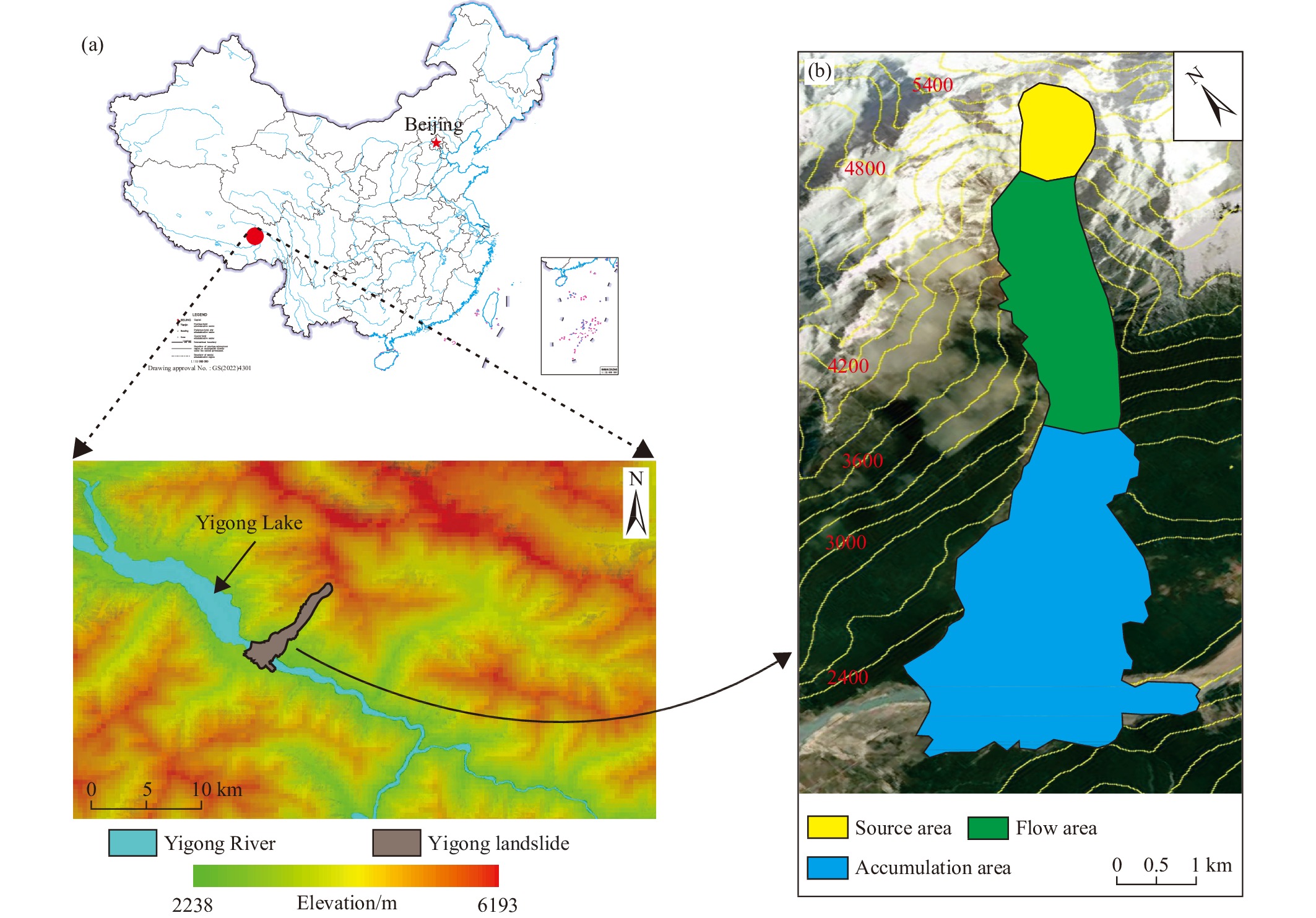

 DownLoad:
DownLoad:
